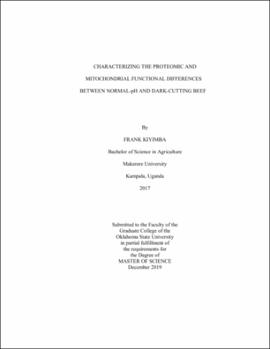| dc.contributor.advisor | Ramanathan, Ranjith | |
| dc.contributor.author | Kiyimba, Frank | |
| dc.date.accessioned | 2020-06-29T17:39:51Z | |
| dc.date.available | 2020-06-29T17:39:51Z | |
| dc.date.issued | 2019-12 | |
| dc.identifier.uri | https://hdl.handle.net/11244/324929 | |
| dc.description.abstract | Dark-cutting beef is an example of color deviation, in which beef fails to have a characteristic bright-red color. The overall goal of the current research was to determine the biochemical basis of dark-cutting beef. Two separate experiments were conducted to determine differential protein expression and mitochondrial functional differences between normal-pH and dark-cutting beef. Protein profiles were identified using proteomic analysis and mitochondrial respiration function was evaluated using a Clark-oxygen electrode. Mass spectrometry analysis identified 1,162 proteins. Of these, 92 proteins were differentially expressed (p < 0.05) between normal-pH and dark-cutting beef. Out of the 92 proteins, we confidently identified 52 proteins whose expression levels changed (by ≥ 1.3 fold). Of these, 27 were up-regulated and 25 were down-regulated in dark-cutting beef. Upregulated proteins were involved in mitochondrial function, muscle contraction, and mitophagy while down-regulated proteins were involved in glycogen and energy reserve metabolism processes and associated with phosphorylase kinase activity, calmodulin, and polysaccharide binding molecular functions. In addition, we observed that mitochondria isolated from dark-cutting beef had greater (P < 0.05) mitochondrial complex II respiration, state III oxygen consumption and uncoupled respiration (p < 0.05), with a greater respiratory control ratio (RCR), and a lower ADP/O ratio compared to normal-pH beef mitochondria. However, no differences (p > 0.05) in mitochondrial complexes I and IV respiration, state IV oxygen consumption and mitochondrial membrane integrity from normal-pH and dark-cutting beef. The results from the current study suggest that a greater expression of mitochondrial electron transport chain proteins supports mitochondrial respiratory function in dark-cutting beef, which can influence color development and stability via oxygen consumption. Understanding the biochemical basis will help to elucidate the etiology of the dark-cutting phenotype. | |
| dc.format | application/pdf | |
| dc.language | en_US | |
| dc.rights | Copyright is held by the author who has granted the Oklahoma State University Library the non-exclusive right to share this material in its institutional repository. Contact Digital Library Services at lib-dls@okstate.edu or 405-744-9161 for the permission policy on the use, reproduction or distribution of this material. | |
| dc.title | Characterizing the proteomic and mitochondrial functional differences between normal-pH and dark-cutting beef | |
| dc.contributor.committeeMember | Hartson, Steven D. | |
| dc.contributor.committeeMember | Mafi, Gretchen G. | |
| dc.contributor.committeeMember | VanOverbeke, Deborah L. | |
| osu.filename | Kiyimba_okstate_0664M_16523.pdf | |
| osu.accesstype | Open Access | |
| dc.type.genre | Thesis | |
| dc.type.material | Text | |
| dc.subject.keywords | bioinformatics | |
| dc.subject.keywords | dark-cutting | |
| dc.subject.keywords | mass spectrometry | |
| dc.subject.keywords | meat color | |
| dc.subject.keywords | mitochondria oxygen consumption | |
| dc.subject.keywords | proteomics | |
| thesis.degree.discipline | Animal Science | |
| thesis.degree.grantor | Oklahoma State University | |
